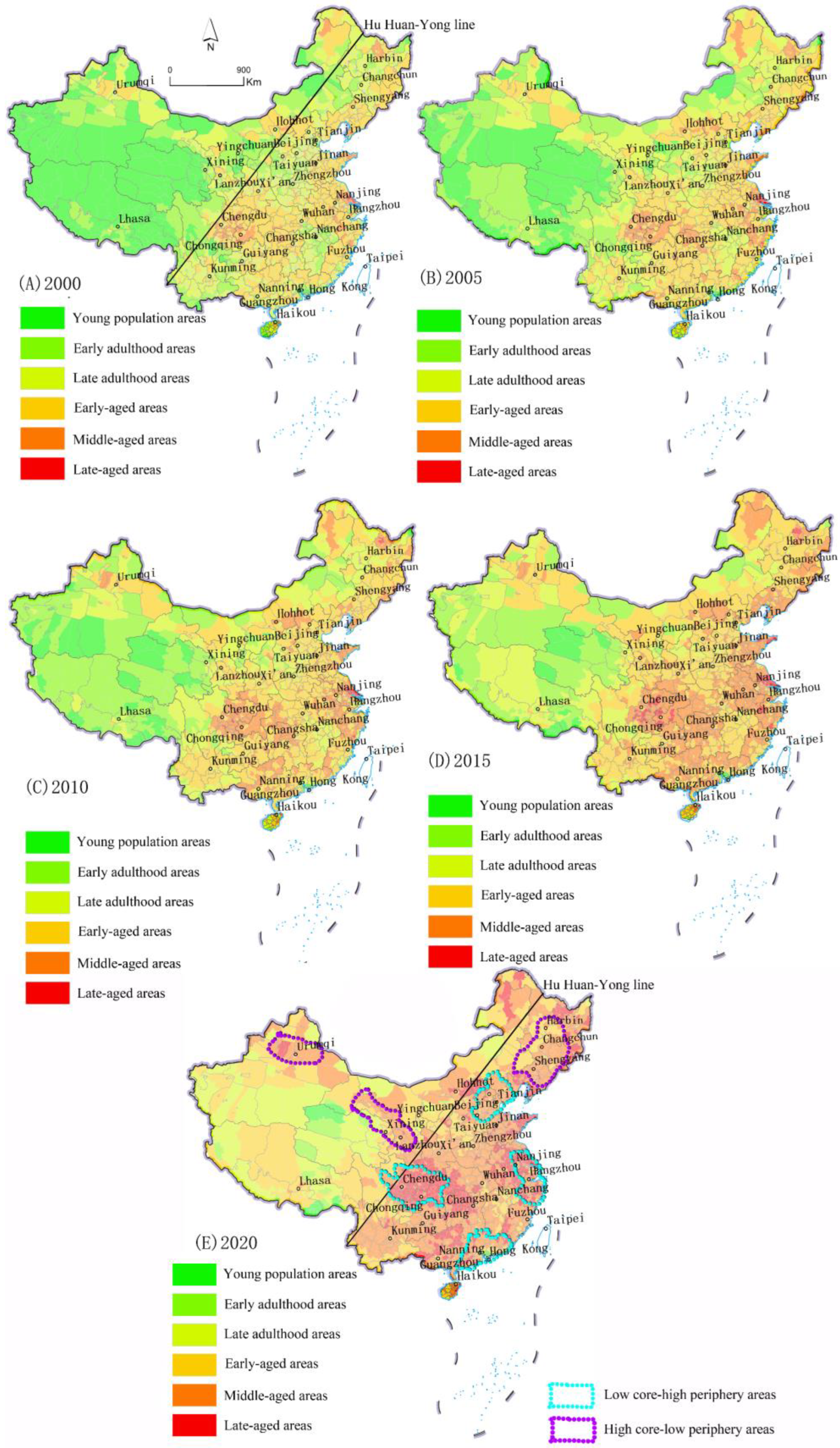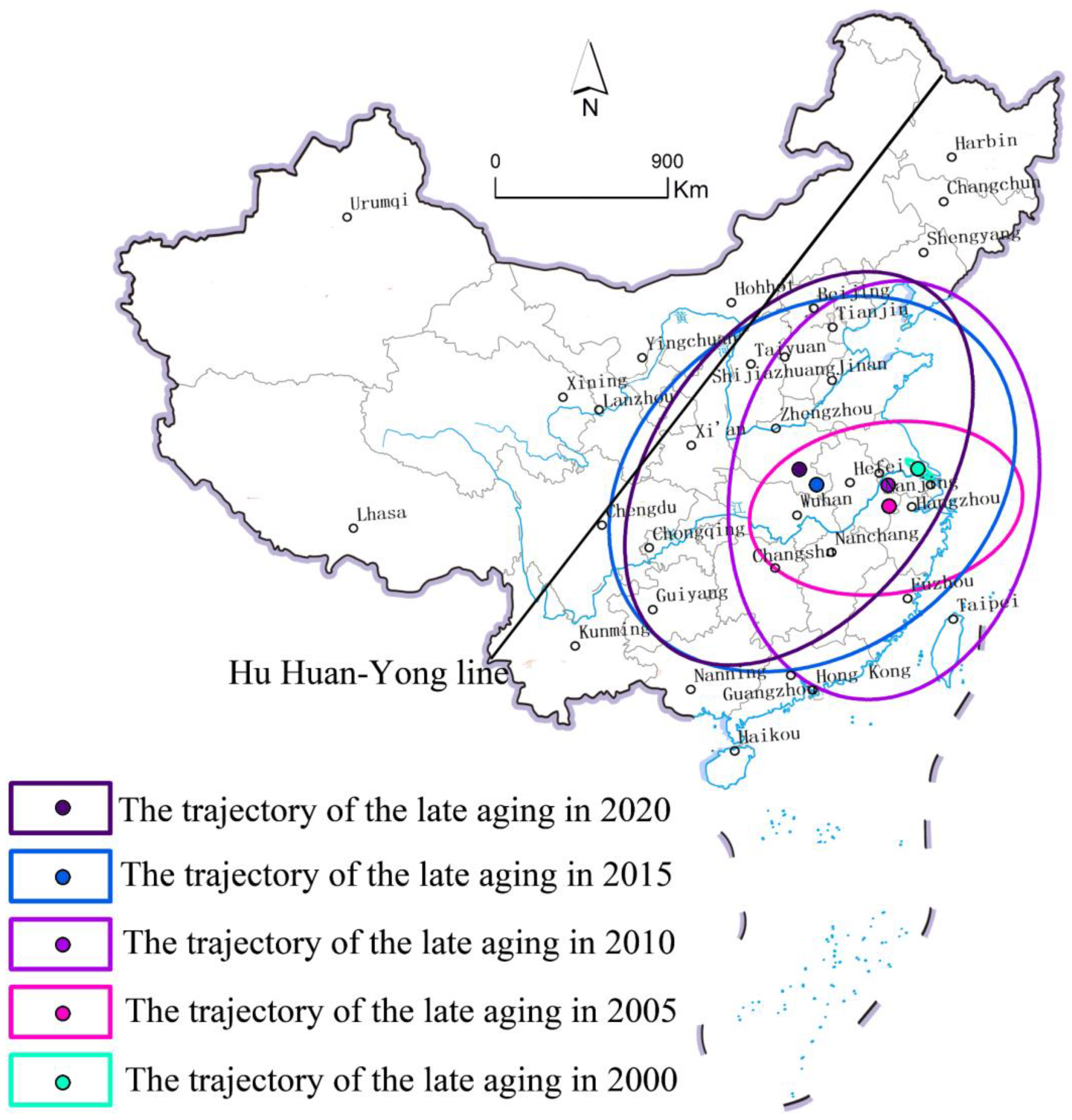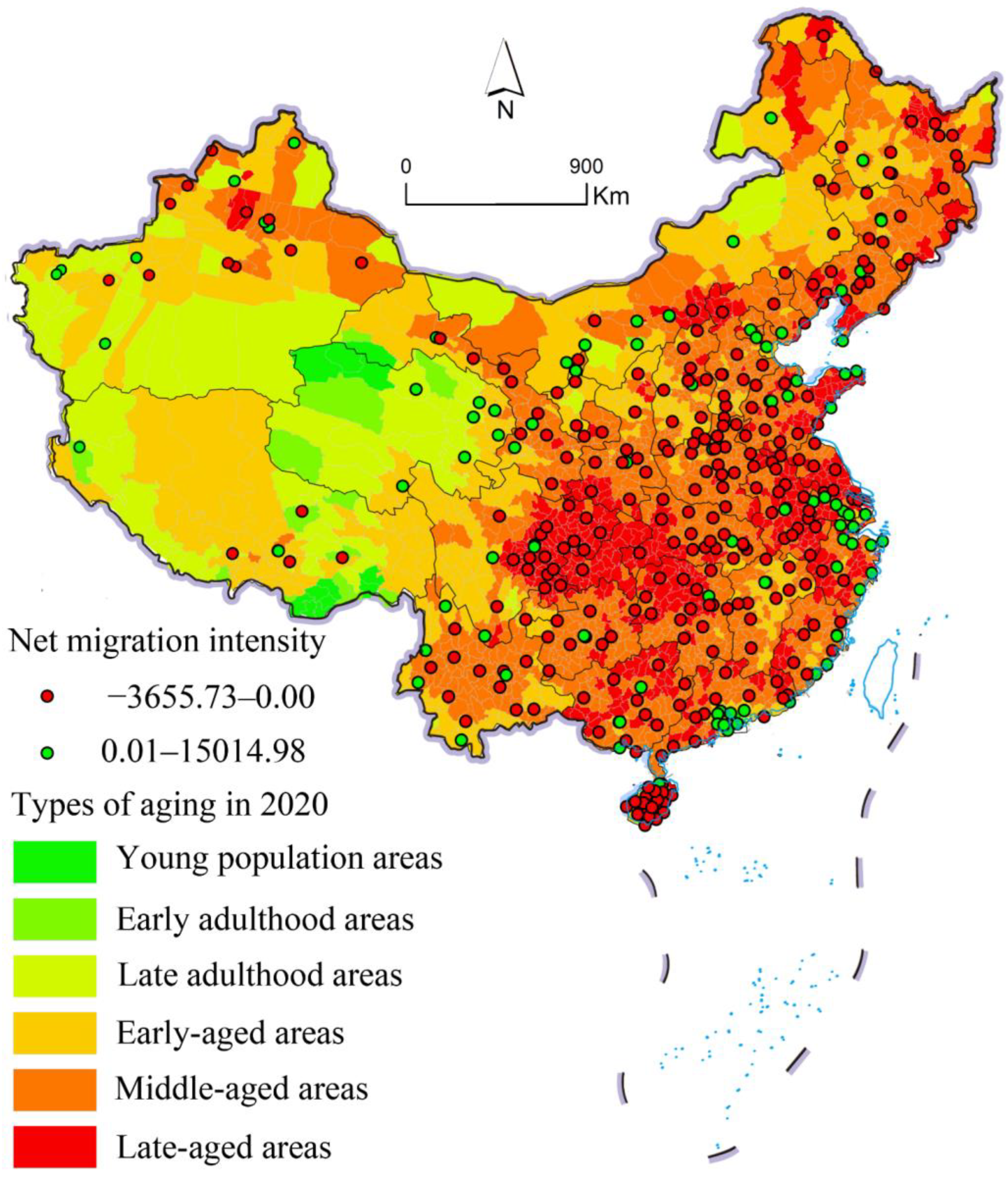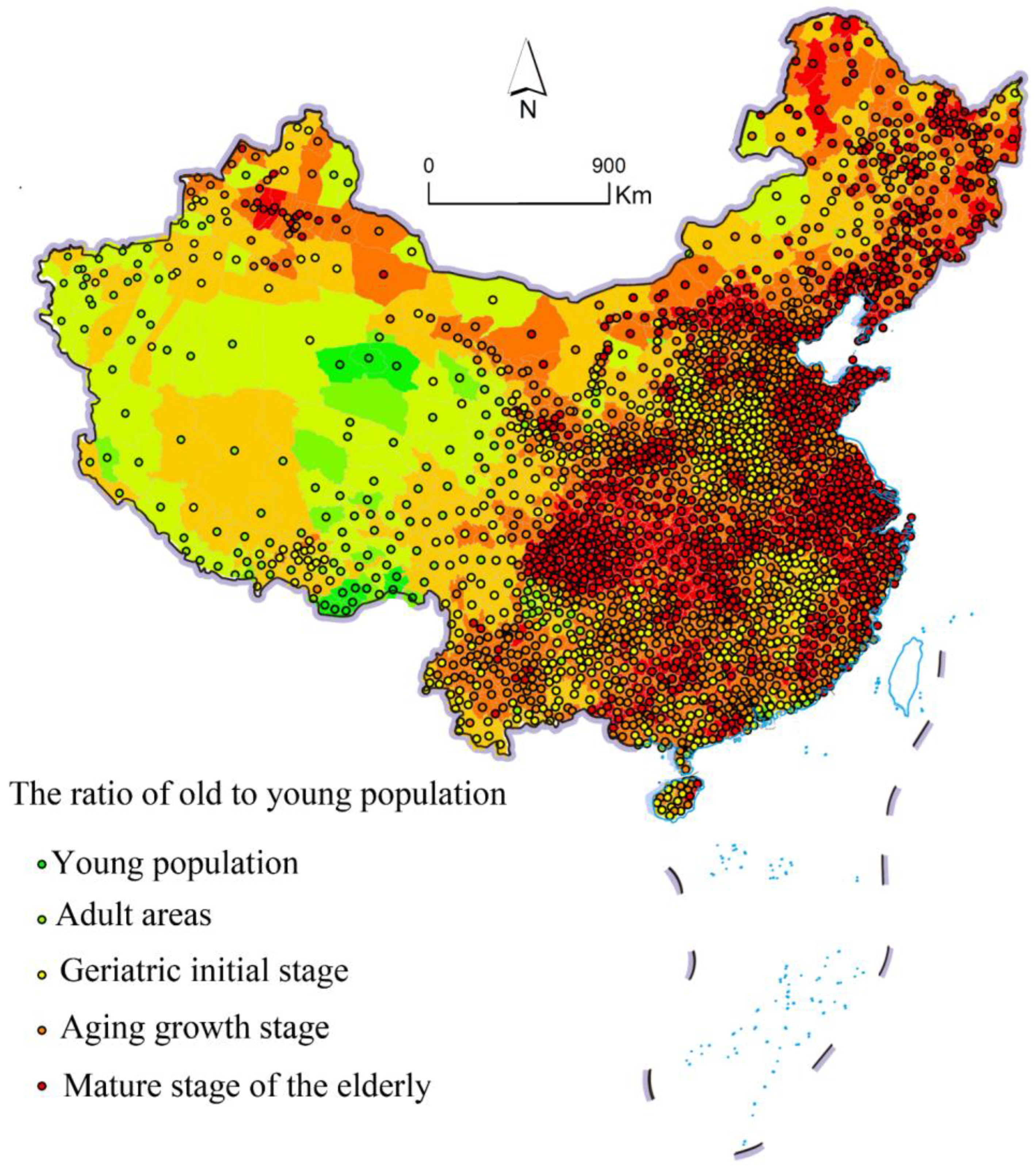Spatiotemporal Dynamic Characteristics and Causes of China’s Population Aging from 2000 to 2020
Abstract
1. Introduction
2. Methods and Materials
2.1. Research Methods
- Aging Index
- 2.
- Aging Rate
- 3.
- Standard Deviation Ellipse
2.2. Data Collection
3. Distribution Characteristics of Population Aging in Different Counties of China
3.1. Spatial Distribution Characteristics of Population Aging
- Spatial pattern of point-line-face
- 2.
- There are two core–periphery aging patterns in China: high core–low periphery and low core–high periphery.
3.2. Population Aging Growth Rate and Type
3.3. Trend of Population Aging
4. Influencing Factors of Population Aging
4.1. Impact of Migration
4.2. Impact of Demographic Structure
4.3. Impact of Traffic Arteries
4.4. Influence of Geographic Environment
5. Conclusions and Discussion
5.1. Conclusions
- China’s population aging presents a point-line-area spread spatial pattern. Especially after 2015, aging has formed a planar structure with the Yangtze River Delta, Chengdu–Chongqing, and other urban agglomerations as the core, and a trend of spreading from the core to the surrounding areas. Three aging urban belts have been formed: Urumqi–Lanzhou–Chongqing–Nanning, Shenyang–Tianjin–Nanjing–Fuzhou, and Chongqing–Wuhan–Hefei. The number of counties with an aging population has increased quickly, and present a dual core–periphery aging model of high core–low periphery and low core–high periphery. The pattern of high core–low periphery is mainly concentrated in areas with a poor economic level, inconvenient transportation, and a bad ecological environment. The pattern of low core–high periphery is mainly concentrated in the Pearl River Delta, Yangtze River Delta, and Beijing–Tianjin–Hebei region, with a developed economy, convenient transportation, and an excellent ecological environment. In this core–periphery aging model, the polarization of population aging in counties is becoming increasingly obvious.
- The aging rate of counties in China is growing rapidly at a large scale and to a deep degree. From 2000 to 2020, the growth rate of counties in the later stage of the elderly type was the fastest, with a rate of 100 times. In addition, 1491 counties entered the elderly stage, accounting for 91.58%. According to the current growth rate of aging, China will enter a super-aging stage with an elderly population of more than 20% in 20 years. It can be seen that China’s population aging is fast, extensive, and deep.
- The aging areas have gradually spread to Northeast, Southwest, Northwest, and Central China. In the future, Heilongjiang, Liaoning, and Jilin in the northeast and Guizhou, Yunnan, Guangxi, and other provinces in the southwest will enter the aging stage at a large scale, along with Hunan, Hubei, Henan, Shanxi, and other provinces in central China. An aging trend spreading across the Hu Huan-Yong line is also shown. The main factors affecting population aging in China’s counties are population migration, population structure change, transportation facility construction, geographic environment concerns, and others.
5.2. Discussion
Author Contributions
Funding
Institutional Review Board Statement
Informed Consent Statement
Data Availability Statement
Conflicts of Interest
References
- Dong, B.; Ding, Q. Aging in China: A challenge or an opportunity? J. Am. Med. Dir. Assoc. 2009, 10, 456–458. [Google Scholar] [CrossRef]
- Chen, F.; Liu, G. Population aging in China. In International Handbook of Population Aging; Springer: Berlin/Heidelberg, Germany, 2009; pp. 157–172. [Google Scholar]
- Xie, B.; Zhou, J.; Luo, X. Mapping spatial variation of population aging in China’s mega cities. J. Maps 2016, 12, 181–192. [Google Scholar] [CrossRef]
- Flynn, C.B. General versus Aged Interstate Migration, 1965–1970. Res. Aging 1980, 2, 165–176. [Google Scholar] [CrossRef]
- Glasgow, N.; Brown, D.L. Rural ageing in the United States: Trends and contexts. J. Rural Stud. 2012, 28, 422–431. [Google Scholar] [CrossRef]
- Burholt, V.; Dobbs, C. Research on rural ageing: Where have we got to and where are we going in Europe? J. Rural Stud. 2012, 28, 432–446. [Google Scholar] [CrossRef]
- Długosz, Z. Population ageing in Europe. Procedia-Soc. Behav. Sci. 2011, 19, 47–55. [Google Scholar] [CrossRef]
- Hartog, R. Europe’s Ageing Cities; Müller + Busmann: Wuppertal, Germany, 2005. [Google Scholar]
- Theou, O.; Cann, L.; Blodgett, J.; Wallace, L.M.; Brothers, T.D.; Rockwood, K. Modifications to the frailty phenotype criteria: Systematic review of the current literature and investigation of 262 frailty phenotypes in the Survey of Health, Ageing, and Retirement in Europe. Ageing Res. Rev. 2015, 21, 78–94. [Google Scholar] [CrossRef]
- Won, C.W. Elderly long-term care in Korea. J. Clin. Gerontol. Geriatr. 2013, 4, 4–6. [Google Scholar] [CrossRef]
- Chomik, R.; McDonald, P.; Piggott, J. Population ageing in Asia and the Pacific: Dependency metrics for policy. J. Econ. Ageing 2016, 8, 5–18. [Google Scholar] [CrossRef]
- Aday, R.H.; Miles, L.A. Long-Term Impacts of Rural Migration of the Elderly: Implications for Research1. Gerontologist 1982, 22, 331–336. [Google Scholar] [CrossRef]
- Botsman, D. Recovering Japan’s urban past: Yoshida Nobuyuki, Tsukada Takashi, and the cities of the Tokugawa period. City Cult. Soc. 2012, 3, 9–14. [Google Scholar] [CrossRef]
- Pan, Z.; Fukuda, H. Research on the Countermeasure of Housing for the Elderly in the Aging Background of Japan—A Case Study on Typical Welfare Facilities of Kitakyushu City in Japan. Procedia-Soc. Behav. Sci. 2016, 216, 119–128. [Google Scholar] [CrossRef]
- Buffel, T.; Phillipson, C. Can global cities be ‘age-friendly cities’? Urban development and ageing populations. Cities 2016, 55, 94–100. [Google Scholar] [CrossRef]
- Długosz, Z.; Raźniak, P. Risk of Population Aging in Asia. Procedia-Soc. Behav. Sci. 2014, 120, 36–45. [Google Scholar] [CrossRef]
- Hiltner, J.; Smith, B.W. Intraurban Residential Location of The Elderly. J. Geogr. 1974, 73, 23–33. [Google Scholar] [CrossRef]
- Goodman, A.C. Using Lorenz Curves to Characterise Urban Elderly Populations. Urban Stud. 1987, 24, 77–80. [Google Scholar] [CrossRef]
- Choi, K.-H.; Shin, S. Population aging, economic growth, and the social transmission of human capital: An analysis with an overlapping generations model. Econ. Model. 2015, 50, 138–147. [Google Scholar] [CrossRef]
- Wister, A.V.; Speechley, M. Inherent tensions between population aging and health care systems: What might the Canadian health care system look like in twenty years? J. Popul. Ageing 2015, 8, 227–243. [Google Scholar] [CrossRef]
- De Meijer, C.; Wouterse, B.; Polder, J.; Koopmanschap, M. The effect of population aging on health expenditure growth: A critical review. Eur. J. Ageing 2013, 10, 353–361. [Google Scholar] [CrossRef]
- Bodner, E.; Shrira, A.; Bergman, Y.S.; Cohen-Fridel, S.; Grossman, E.S. The interaction between aging and death anxieties predicts ageism. Pers. Individ. Differ. 2015, 86, 15–19. [Google Scholar] [CrossRef]
- Boschmann, E.E.; Brady, S.A. Travel behaviors, sustainable mobility, and transit-oriented developments: A travel counts analysis of older adults in the Denver, Colorado metropolitan area. J. Transp. Geogr. 2013, 33, 1–11. [Google Scholar] [CrossRef]
- Kemperman, A.; Timmermans, H. Green spaces in the direct living environment and social contacts of the aging population. Landsc. Urban Plan. 2014, 129, 44–54. [Google Scholar] [CrossRef]
- Rogers, A.; Watkins, J. General versus elderly interstate migration and population redistribution in the United States. Res. Aging 1987, 9, 483–529. [Google Scholar] [CrossRef] [PubMed]
- Zhan, P.; Ma, X.; Li, S. Migration, population aging, and income inequality in China. J. Asian Econ. 2021, 76, 101351. [Google Scholar] [CrossRef]
- Kim, D.-W.; Fabbiano, G. X-ray properties of young early-type galaxies. I. X-ray luminosity function of low-mass X-ray binaries. Astrophys. J. 2010, 721, 1523–1530. [Google Scholar] [CrossRef]
- Yin, C.; Meng, F.; Yang, X.; Yang, F.; Fu, P.; Yao, G.; Chen, R. Spatio-temporal evolution of urban built-up areas and analysis of driving factors —A comparison of typical cities in north and south China. Land Use Policy 2022, 117, 106114. [Google Scholar] [CrossRef]
- Lu, J.; Liu, Q. Four decades of studies on population aging in China. China Popul. Dev. Stud. 2019, 3, 24–36. [Google Scholar] [CrossRef]
- Cangping, W. The Aging Population in China. In International Institute on Ageing; Springer: Berlin/Heidelberg, Germany, 1991. [Google Scholar]
- Jie, Z. Spatial Distribution Characteristics and Evolution Trends of Urban Aging Population. China City Plan. Rev. 2017, 26, 6–15. [Google Scholar]
- Han, Y.; He, Y.; Lyu, J.; Yu, C.; Bian, M.; Lee, L. Aging in China: Perspectives on public health. Glob. Health J. 2020, 4, 11–17. [Google Scholar] [CrossRef]
- Wang, L.; Li, Y.; Li, H.; Holdaway, J.; Hao, Z.; Wang, W.; Krafft, T. Regional aging and longevity characteristics in China. Arch. Gerontol. Geriatr. 2016, 67, 153–159. [Google Scholar] [CrossRef]
- Chen, S. Aging with Chinese Characteristics: A Public Policy Perspective. Ageing Int. 2009, 34, 172–188. [Google Scholar] [CrossRef]
- Xu, F.; Huang, Y.; Wang, Q. Aging Industries in the Regional Economy: How to Support an Aging China? Land 2022, 11, 2096. [Google Scholar] [CrossRef]
- Chou, K.-L.; Chi, I. Successful Aging among the Young-Old, Old-Old, and Oldest-Old Chinese. Int. J. Aging Hum. Dev. 2002, 54, 1–14. [Google Scholar] [CrossRef] [PubMed]
- Zhou, Y.; Li, N.; Wu, W.; Wu, J.; Shi, P. Local Spatial and Temporal Factors Influencing Population and Societal Vulnerability to Natural Disasters. Risk Anal. 2014, 34, 614–639. [Google Scholar] [CrossRef] [PubMed]
- Duan, L.; Liu, Z.; Yu, W.; Chen, W.; Jin, D.; Feng, Y.; Wang, Y.; Liu, J.; Zhou, H.; Sun, S.; et al. The provincial trend of population aging in China–based on population expansion forecast formula. J. Comput. Methods Sci. Eng. 2022, 22, 349–359. [Google Scholar] [CrossRef]
- Qu, B.; Li, X.; Liu, J.; Mao, J. Analysis of the Current Situation Regarding the Aging Rural Population in China and Proposed Countermeasures. Popul. Health Manag. 2012, 15, 181–185. [Google Scholar] [CrossRef]
- Kang, J.J.; Ding, Z.W.; Zhang, G.s.S.; Wang, F.Z.; Wu, R.W. Multi scale spatial-temporal pattern of population aging in Central Plains. Econ. Geogr. 2016, 36, 29–37. [Google Scholar] [CrossRef]
- Feng, J.; Hong, G.; Qian, W.; Hu, R.; Shi, G. Aging in China: An International and Domestic Comparative Study. Sustainability 2020, 12, 5086. [Google Scholar] [CrossRef]
- Wu, Y.; Song, Y.; Yu, T. Spatial Differences in China’s Population Aging and Influencing Factors: The Perspectives of Spatial Dependence and Spatial Heterogeneity. Sustainability 2019, 11, 5959. [Google Scholar] [CrossRef]
- Guan, D.; Lei, L.; Han, Z. Spatial-Temporal Variation of Population Aging: A Case Study of China’s Liaoning Province. Complexity 2020, 2020, 5436061. [Google Scholar] [CrossRef]
- National Development and Reform Commission. Analysis of the situation and development of population and health in China. Macroecon. Manag. 2004, 5, 15–19. [Google Scholar] [CrossRef]
- Yin, W.Y. Future population change and sustainable development in Zhejiang. J. Zhejiang Univ. Humanit. Soc. Sci. Ed. 2000, 30, 142. [Google Scholar] [CrossRef]
- Hajkowicz, S.; Cook, H.; Wilhelmseder, L.; Boughen, N. The Future of Australian Sport: Megatrends Shaping the Sports Sector over Coming Decades; Australian Sports Commission: Bruce, Australia, 2013.
- Liu, C.M. Research on population aging standards. J. Popul. Sci. 1991, 3, 8–11. [Google Scholar] [CrossRef]
- Rogers, A.; Woodward, J.A. Tempos of Elderly Age and Geographical Concentration*. Prof. Geogr. 1992, 44, 72–83. [Google Scholar] [CrossRef]
- Djernes, J.K. Prevalence and predictors of depression in populations of elderly: A review. Acta Psychiatr. Scand. 2006, 113, 372–387. [Google Scholar] [CrossRef]
- Lan, T.; Yu, M.; Xu, Z.; Wu, Y. Temporal and Spatial Variation Characteristics of Catering Facilities Based on POI Data: A Case Study within 5th Ring Road in Beijing. Procedia Comput. Sci. 2018, 131, 1260–1268. [Google Scholar] [CrossRef]
- Kozak, I.; Kozak, H. Analysis of settlings of Lutoviska commune since 2nd half of 18th century using GIS. Visnyk Lviv Univ. Ser. Geogr. 2016, 50, 198–207. [Google Scholar] [CrossRef]
- Sorichetta, A.; Bird, T.J.; Ruktanonchai, N.W.; Erbach-Schoenberg, E.z.; Pezzulo, C.; Tejedor, N.; Waldock, I.C.; Sadler, J.D.; Garcia, A.J.; Sedda, L. Mapping internal connectivity through human migration in malaria endemic countries. Data 2016, 3, 160066. [Google Scholar] [CrossRef]
- Sorichetta, A.; Hornby, G.M.; Stevens, F.R.; Gaughan, A.E.; Linard, C.; Tatem, A.J. High-resolution gridded population datasets for Latin America and the Caribbean in 2010, 2015, and 2020. Sci. Data 2015, 2, 150045. [Google Scholar] [CrossRef]
- Fu, Y.; Lin, S.; Xu, Z. Research on Quantitative Analysis of Multiple Factors Affecting COVID-19 Spread. Int. J. Environ. Res. Public Health 2022, 19, 3187. [Google Scholar] [CrossRef]
- Wei, S.; Wang, L. Examining the population flow network in China and its implications for epidemic control based on Baidu migration data. Humanit. Soc. Sci. Commun. 2020, 7, 145. [Google Scholar] [CrossRef]
- Zhang, X.D.; Han, H.Y.; Tang, Y.J.; Luo, G.N. Research on the characteristics of urban network structure in China based on baidu migration data. J. Geo-Inf. Sci. 2021, 23, 1798–1808. [Google Scholar] [CrossRef]
- Ruan, J.; Chen, Y.; Yang, Z. Assessment of temporal and spatial progress of urban resilience in Guangzhou under rainstorm scenarios. Int. J. Disaster Risk Reduct. 2021, 66, 102578. [Google Scholar] [CrossRef]
- Wang, S. Spatial patterns and social-economic influential factors of population aging: A global assessment from 1990 to 2010. Soc. Sci. Med. 2020, 253, 112963. [Google Scholar] [CrossRef]
- Xue, P.; Liu, J.; Liu, B.; Zhu, C. Impact of Urbanisation on the Spatial and Temporal Evolution of Carbon Emissions and the Potential for Emission Reduction in a Dual-Carbon Reduction Context. Sustainability 2023, 15, 4715. [Google Scholar] [CrossRef]
- Gu, J. Excellent living environment is the basic condition for nurturing centenarians—Analysis of the origin of the phenomenon of longevity in Nantong. Chin. J. Mouth Sci. 2001, 1, 89–91. [Google Scholar]
- Wu, L.; Huang, Z.; Pan, Z. The spatiality and driving forces of population ageing in China. PLoS ONE 2021, 16, e0243559. [Google Scholar] [CrossRef] [PubMed]
- Kato, H. Urban modeling of shrinking cities through Bayesian network analysis using economic, social, and educational indicators: Case of Japanese cities. PLoS ONE 2023, 18, e0284134. [Google Scholar] [CrossRef] [PubMed]
- Peng, W.; Wu, Z.; Duan, J.; Gao, W.; Wang, R.; Fan, Z.; Liu, N. Identifying and quantizing the non-linear correlates of city shrinkage in Japan. Cities 2023, 137, 104292. [Google Scholar] [CrossRef]
- Campbell, J.Y.; Ramadorai, T.; Ranish, B. Do the rich get richer in the stock market? Evidence from India. Am. Econ. Rev. Insights 2019, 1, 225–240. [Google Scholar] [CrossRef]
- Engelhardt, H. Recent Changes in Family Policies in Austria and Germany-A Response to Very Low Fertility. Entre Nous 2006. Available online: https://opus4.kobv.de/opus4-bamberg/frontdoor/index/index/docId/ (accessed on 14 March 2023).
- Liu, D.; Pu, Y.; Han, H.; Wang, Y.; Song, X. Study on the Changing Spatial Focusing of Inter-Provincial Migration in China Based on Gini Index International Conference on Geoinformatics. IEEE, 2015. Available online: https://www.zhangqiaokeyan.com/academic-conference-foreign_meeting_thesis/0705011088107.html (accessed on 14 March 2023).
- Yu, T. China’s aging population and its spatial features in city areas (2000—2010). Urban Plan. Forum 2013, 6, 58–66. [Google Scholar]
- Zhao, D.; Han, Z.; Wang, L. The spatial pattern of aging population distribution and its generating mechanism in China. Acta Geo-Graph. Sin. 2017, 72, 1762–1775. [Google Scholar]







| Population Type | 2000 | 2005 | 2010 | 2015 | 2020 | ||||
|---|---|---|---|---|---|---|---|---|---|
| Number of Counties | Number of Counties | Growth Rate (%) | Number of Counties | Growth Rate (%) | Number of Counties | Growth Rate (%) | Number of Counties | Growth Rate (%) | |
| Young population type | 205 | 124 | −39.51% | 65 | −47.58% | 31 | −52.31% | 18 | −41.94% |
| Early adulthood type | 467 | 282 | −39.61% | 204 | −27.66% | 118 | −42.16% | 20 | −83.05% |
| Late adulthood type | 956 | 767 | −19.77% | 513 | −33.12% | 247 | −51.85% | 99 | −59.92% |
| Early-aged type | 1107 | 1371 | 23.84% | 1520 | 10.87% | 1345 | −11.51% | 539 | −59.93% |
| Middle-aged type | 164 | 345 | 110.37% | 574 | 66.38% | 1070 | 86.41% | 1562 | 45.98% |
| Late-aged type | 6 | 16 | 166.67% | 29 | 81.25% | 94 | 224.14% | 667 | 609.57% |
Disclaimer/Publisher’s Note: The statements, opinions and data contained in all publications are solely those of the individual author(s) and contributor(s) and not of MDPI and/or the editor(s). MDPI and/or the editor(s) disclaim responsibility for any injury to people or property resulting from any ideas, methods, instructions or products referred to in the content. |
© 2023 by the authors. Licensee MDPI, Basel, Switzerland. This article is an open access article distributed under the terms and conditions of the Creative Commons Attribution (CC BY) license (https://creativecommons.org/licenses/by/4.0/).
Share and Cite
Zhang, X.; Han, H. Spatiotemporal Dynamic Characteristics and Causes of China’s Population Aging from 2000 to 2020. Sustainability 2023, 15, 7212. https://doi.org/10.3390/su15097212
Zhang X, Han H. Spatiotemporal Dynamic Characteristics and Causes of China’s Population Aging from 2000 to 2020. Sustainability. 2023; 15(9):7212. https://doi.org/10.3390/su15097212
Chicago/Turabian StyleZhang, Xiaodong, and Haoying Han. 2023. "Spatiotemporal Dynamic Characteristics and Causes of China’s Population Aging from 2000 to 2020" Sustainability 15, no. 9: 7212. https://doi.org/10.3390/su15097212
APA StyleZhang, X., & Han, H. (2023). Spatiotemporal Dynamic Characteristics and Causes of China’s Population Aging from 2000 to 2020. Sustainability, 15(9), 7212. https://doi.org/10.3390/su15097212





